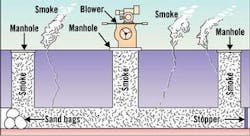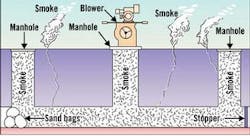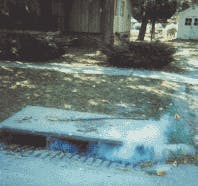Smoke Testing 101: An Introduction to Smoke Testing
Used extensively for over 40 years, smoke testing has proven to be a vital ingredient of successful inflow and infiltration (I&I) studies. It is as important now as it has ever been as growing municipalities increase demands on aging, often deteriorating collection systems. In addition, programs such as EPA's new CMOM (capacity, maintenance, operations, and maintenance) rule emphasize a focus on proactive, preventive maintenance practices. Smoke testing is an effective method of documenting sources of inflow and should be part of any CMOM program.
Just as a doctor would require the aid of several instruments to evaluate the status of one's health, various test methods should be used in performing a complete sanitary sewer evaluation survey (SSES). In addition to smoke testing, these could include dyed water testing, manhole inspection, TV inspection, flow monitoring, and more. Specializing in sanitary sewer evaluation surveys, Wade & Associates of Lawrence, KS, has found a reduction of 30 to 50 percent in peak flows can be expected as a result of implementing these types of programs.
Smoke testing is a relatively simple process which consists of blowing smoke mixed with larger volumes of air into the sanitary sewer line. Usually induced through the manhole, the smoke travels the path of least resistance and quickly shows up at sites that allow surface water inflow. Smoke will identify broken manholes, illegal connections (including roof drains, sump pumps, yard drains and more), uncapped lines, and will even show cracked mains and laterals providing there is a passageway for the smoke to travel to the surface.
Although video inspection and other techniques are certainly important components of an I&I survey, research has shown that approximately 65 percent of all extraneous stormwater inflow enters the system from somewhere other than the main line. Smoke testing is an excellent method of inspecting both the mainlines, laterals and more. Smoke travels throughout the system, identifying problems in all connected lines, even sections of line that were not known to exist or thought to be independent or unconnected. Best results are obtained during dry weather which allows smoke better opportunity to travel to the surface.
Needed Equipment
Blowers: Most engineering specifications for smoke testing identify the use of a blower able to provide 1750 cfm (cubic feet of air per minute), however in today's world it seems to be the mindset that bigger is better. New smoke blowers on the market can deliver over 3000 cfm, but is this really needed? Once the manhole area is filled, the smoke only needs to travel through sections of generally eight or 10-inch pipe. Moving the air very quickly is useless if the blower does not have the static pressure to push that air/smoke through the lines. If you've used high CFM blowers and found that smoke frequently backs up to the surface, this may be your problem. There are two types of blowers available for smoke testing sewers: squirrel cage and direct drive propeller. In general, squirrel cage blowers are usually larger in size and can provide more static pressure in relation to CFM. The output of the squirrel cage type is usually adjustable by alternating pulleys and belts to meet the demands of the job. Propeller style blowers are usually more compact and generally offer approximately 3,200 CFM. Other than reducing the engine throttle, the output is not adjustable since the fan blade is attached directly to the engine shaft.
Smoke Types: There are two types of smoke currently offered for smoke testing sewers, classic smoke candles and smoke fluids. Smoke candles were first used for testing sewers when the process began its popularity back in 1961, and continue to be the most widely used. They are used by simply placing a smoke candle on the fresh air intake side of the blower. Once ignited, the exiting smoke is drawn in with the fresh air and blown down into the manhole and throughout the system.Smoke candle are available in various sizes that can be used singularly or in combination to meet any need. This type of smoke is formed by a chemical reaction, creating a smoke which contains a high content of atmospheric moisture. It is very visible even at low concentrations, and extremely effective at finding leaks.
Another available source of smoke is a smoke fluid system. Although they have just recently been more aggressively marketed, smoke fluids became available for sewer testing shortly after smoke candles, some 30 years ago. They can be used effectively, but it is important to understand how they work. This system involves injecting a smoke fluid (usually a petroleum based product) into the hot exhaust stream of the engine where it is heated within the muffler (or heating chamber) and exhausted into the fresh air intake side of the blower.
One gallon of smoke fluid is generally less expensive than one dozen smoke candles, however smoke fluids do not consistently provide the same quality of smoke. When using smoke fluid, it is important to understand that as fluid is injected into the heating chamber (or muffler) it immediately begins to cool the unit. The heating chamber will eventually reach a point where it is not hot enough to completely convert all the fluid to smoke, thus creating thin/wet smoke. This can happen quickly depending on the rate of fluid flow.
If the smoke has become thin it can be especially difficult to see at greater distances. Blocking off sections of line is usually a good idea with any type of smoke, but becomes almost a necessity when using smoke fluid. Some manufactures have taken steps to address this issue and now offer better flow control, fluid distribution, and most importantly insulated heating chambers to help maintain necessary temperatures.
Safety: One of the more talked about yet least understood aspects of smoke testing is the use and safety of these products. As manufacturers have become more competitive, some marketing programs and advertisements have implied danger in the use of competitive types of smoke products. Laboratory reports, scientific studies, and even Material Safety Data Sheets can be quite confusing to those who are not trained nor qualified to make scientific judgments on this data. Having this information delivered to us in the form of advertising can be dangerous, as most of us tend to believe what we read.
An author of an associated industry publication once statedellipse "Do not use smoke bombs, as they give off a toxic gas." Although the author quotes no scientific literature to support this statement, competitive propaganda has made such implications. It is interesting to note that the same exact statement could be made for smoke fluids. Smoke from fluid is created in the exhaust system of the engine, which contains carbon monoxide. Is carbon monoxide not a toxic gas?
Other statements that have been made include warnings to wear a respirator while smoke testing. While certain manufacturers have issued this warning about competitive products, they do not qualify the statement, nor do they mention the fact that the same thing could be said of their own product. The fact is that a respirator should be worn whenever a person would be exposed to any substance in quantities that exceeded OSHA limits. Would smoke testing personnel be exposed to enough smoke to exceed these limits? Not likely. The bottom line on safety is that it is important to use common sense. All smokes, candles and fluids can be used safely and effectively when used as directed.
When planning to smoke test, it is important to develop a proactive public notice program. Ads in local papers, door hangers, mailers, as well as door to door inquiries are recommended. It is helpful to educate the public as to why the test is being performed and the positive benefits to the community. In addition, the notification program should instruct residents on what to do and who to call if smoke should enter their homes. It is also important to notify local police and fire departments daily as to where and when smoke testing will take place.
About the Author: Paul Tashian is employed by Superior Signal Company Inc., a manufacturer of all types of smoke testing equipment, and a major contributor to the original development of smoke testing practices. Also, thanks to Wade & Associates (a company specializing in sanitary sewer evaluation surveys) for offering reference material, and providing artwork and photographs used in this article.


